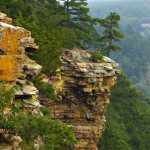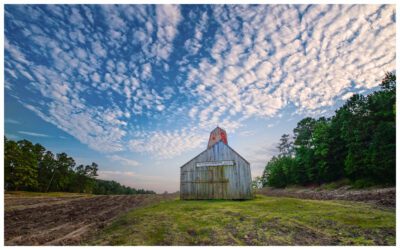[title subtitle=”words: Dwain Hebda
images:courtesy Arkansas Department of Parks & Tourism”][/title]
The quiet things in life are often the most underrated, overlooked simply because they are quiet. In our hyper-stimulated, uber-connected world, we’ve lost something of the innocence that takes delight in being still, that hears the music in the silence. Even as we thirst to be plugged in, we’re more disconnected than ever; in our hunger to stand out, we’ve forgotten our place in the universe.
Therein lies the restorative magic of Petit Jean State Park, a 2,600-acre gem sitting astride the easternmost section of the Petit Jean mountains just south of Morrilton in the Arkansas River Valley. There are no roller coasters up here; no animatronic dinosaurs either. In some places of the park, it’s dicey getting so much as a cell signal. What it does have—in fact, what it is—is a time machine; a portal to the days of station wagons and picnic baskets, a campfire tale come to life, a living Polaroid burnished at the edges.

Petit Jean is Arkansas’ first state park. While there were some dandies to follow, the state has never quite improved on the original. Petit Jean is set on the largest of the rippling humps that make up this mountain range across Yell, Logan, Scott and Conway counties, that looms indigo, azure, and sapphire in the morning mist.
The Museum of Automobiles is up here, founded by the late Governor Winthrop Rockefeller, as is the headquarters of the Winthrop Rockefeller Foundation. There’s an airport too, plus a bevy of small businesses catering to the tourists, such as a motel, petting zoo and riding stables, assorted youth campgrounds and private acreages. The quaint First Baptist Church, its bleached white steeple aimed ever-heavenward, nestles peacefully around one bend.
Slipping through the veil of pines at the park entrance, the filtered light of the forest splashes off hulking shale boulders and smooth, flat sandstone. For the beginner, it’s hard to take everything in; for those who come here often, the natural beauty and sheer scale of the surroundings still stop them in their tracks.
There are cabins and campgrounds a-plenty at Petit Jean State Park as well as the stunning Adirondack-style Mather Lodge with twenty-four rooms, a restaurant and swimming pool. Those wishing to go native can rent a yurt or teepee, but most overnight visitors pitch tents or park campers and RVs in one of the designated camping areas. Along the shoreline of Lake Bailey, youngsters of all ages drop a line from the fishing dock, launch a rented canoe or other watercraft and picnic under the pines. Outdoor tennis and basketball courts, playgrounds and ball fields add to the recreational amenities.
The story of Petit Jean Mountain is filled with natural wonder and human drama. In the 1700s a young French nobleman named Chavet received a royal grant to claim land in the New World. His Parisian fiancée, Adrienne Dumont, wanted to move up their wedding so as to accompany him, but he refused in order to spare her the hardships of the journey, instead saying they would marry upon his return. Not wanting to be left behind, Dumont disguised herself and applied for a job as cabin boy on the ship carrying her unsuspecting suitor.
The ruse worked; legend has it even Chavet didn’t recognize Petit Jean, which is French for “Little John,” as the sailors dubbed her. The expedition traversed the ocean, traveled up the Mississippi and Arkansas Rivers, and arrived at the foot of the mountain where they were welcomed by the native peoples. Dumont kept up the disguise all summer, only to grow ill in the fall just as the party was preparing to return to France. At that time, her true identity was discovered. Before her death, she begged her beloved’s forgiveness and asked to be buried atop the mountain, a request that was granted on a spot overlooking the river.
Today, Petit Jean’s grave is marked and preserved, but it is the view of the river valley below that makes the tale all the more dramatic. The patchwork farms and pastureland, trimmed in the curling ribbon of the Arkansas River, race out in every direction below the massive overlook. The State Parks Service has constructed viewing platforms where visitors can take in all this beauty.
More solid sights may be found along the Seven Hollows hiking trail, a loop that passes through a series of small canyons, through dense hardwood forest. Sights include a natural stone arch, box canyon and various caves and crannies that sheltered humans for hundreds of years. The four-and-a-half-mile trail is ranked as moderately difficult.
Settlers eventually came to the mountain: In 1845 John Walker of Tennessee became the first white settler on Petit Jean. His original cabin, built on the north side of Lake Bailey, was restored by Civilian Conservation Corps and can be seen today in the park. In 1891, Dan Nelson built a mansion on a choice point overlooking the river valley not far from Petit Jean’s gravesite. Over the years, the mansion changed hands, was used as a hotel and finally donated to the YMCA which used it as a camp before it was torn down.
By the dawn of the twentieth century, much of the land that would become the park was in private hands, including the Seven Hollows portion owned by Fort Smith Lumber Company. The difficulty of logging combined with the overwhelming natural beauty of the place eventually planted the seed for preserving the area as a national park. That bid failed, but thanks to the work of Dr. T.W. Hardison, Petit Jean State Park was established in 1923, one of the first such spaces in the South.
For Hardison, like the native people, explorers and pioneers before him, and the thousands upon thousands of visitors that came after, the showstopper at Petit Jean is Cedar Falls. It’s a spectacular waterfall in the center of the park that tumbles ninety-five feet to the basin below. The cliff face is equally beautiful as the water itself, having been shaped by time and weather into a concave backdrop for the snow-white falls.
The waterfall is stunning viewed from the handicap-accessible overlook area built by the Parks Department. For a truly unforgettable experience, take the hiking trail from Mather Lodge to the base of the falls, roughly a one-mile jaunt of easy to moderate exertion.
A visit to Petit Jean State Park is the antidote for anything the modern world can dish out, reintroducing families to the art of walking dogs, riding bikes and joining at dusk in the melody of laughter harmonized with crackling campfires.
Petit Jean State Park
1285 Petit Jean Mountain Road, Morrilton, AR
501.727.5441
petitjeanstatepark.com
Directions:
From the west, travel Interstate 40 to Arkansas Highway 7, south at Russellville, then east on Petit Jean Mountain Road at Centerville. From the east, travel Interstate 40 to Arkansas Highway 9 at Morrilton, turn west onto Arkansas Highway 154 (turns into Petit Jean Mountain Road) at Oppelo.
Upcoming Events:
May 12
Arkansas Heritage Day
Visit Petit Jean to learn more about the park’s history and heritage, including the story of the structures built by the Civil Conservation Corps in the 1930s.
June 12-16
60th Annual Auto Show and Swap Meet
Museum of Automobiles on Petit Jean Mountain
Antique car show, with classic and vintage automobiles from all over the region are on display. Call the Museum of Automobiles on Petit Jean Mountain at 501.727.5427 for more information.









